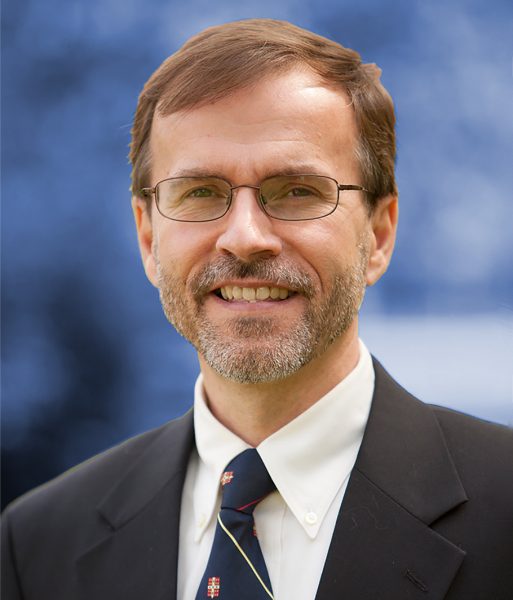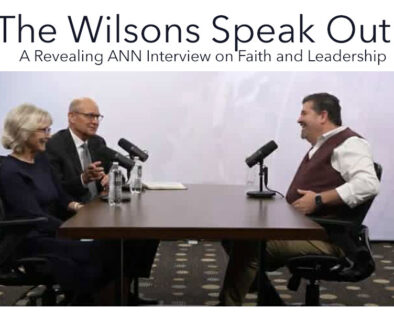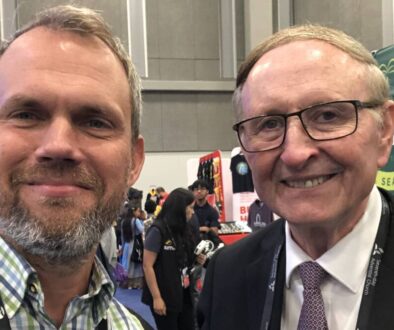The Institutional Church
By Denis Fortin | 14 October 2020 |
It should not come as a surprise to anyone anymore when we say that our denomination is a hierarchical institution. In an earlier article,[1] I argued that the Seventh-day Adventist Church is a hybrid form of episcopalism similar to that of the Methodist Church in the United States. This represents a weakening of our Protestant heritage, meaning that Seventh-day Adventism is in dire need of a major realignment of its ecclesiology and ecclesial practices.
Avery Dulles
I am relying as a guide for this analysis on Avery Dulles’ book Models of the Church, a classic textbook in ecclesiology. First published in 1974, the book articulates models of the basic functions and roles of the church in the life of believers as well as its mission on Earth, each model highlighting aspects of the church that are essential to its comprehensive identity.
Dulles, a Roman Catholic Jesuit scholar, was one of the architects of a post-Vatican II reshaping of Catholic faith and practices, and Models of the Church offered paradigms of the church that Catholics could endorse in order to see in Protestant churches true brothers and sisters also belonging to the Body of Christ. Like no other Catholic theologian before him, Dulles was able to show how the church of Christ on Earth is bigger than any particular denomination, including his own.
Dulles’ five models show the strengths and weaknesses of how the church is present in the world as institution, mystical communion, sacrament, herald, and servant. His later 1987 edition added a sixth mode: the church as the community of disciples. (Page numbers in parentheses refer to the 1987 edition.) The positive response the book received was also the result of Dulles’ moderate and cordial tone in his appraisal of both Catholic and Protestant views of the church.
Forty-some years later, Models of the Church is still a starting point in any discussion of the church. While his model of the church as sacrament has become the dominant model in Catholic and many Protestant ecclesiologies, the paradigm of the church as the community of disciples of Jesus, along with the model of the church as servant (diakonia) of the people of God, is emphasized today by the World Council of Churches in creating relationships between member churches.
But it is the model of the church as an institution that should especially interest us Seventh-day Adventists. I believe we must pay close attention to Dulles’ critiques of the institutional model of his own church, because I fear we may be making the same mistakes.
The Institutional Church
While for Dulles the church is a communion of people with one another, it is nonetheless also God’s mysterious work of grace in Christ. Along with its structures, organization, and rituals, the church contains an element of mystery as God’s “unsearchable riches” (Eph. 3:8, KJV) in Christ (17). It is God’s instrument to bring people to salvation.
Yet the dominant model through the centuries has been the institutional model, with its political connotation of the church as the “perfect society.” It is a society rooted in a long history with a constitution, a set of rules, a governing body, and a set of members who accept its constitution and rules as binding upon them (34). The church has its recognized ministers, accepted confessional formulas, and prescribed forms of worship and rituals. Since New Testament times, all of this has been fitting and proper (35).
But the church has always had to contend with institutionalism, which has treated the institutional element as primary and indispensable.
It is toward the end of the Middle Ages, and after the Catholic Counter-Reformation to Protestant criticisms, that the Roman Catholic Church became overwhelmingly preoccupied with its institutional elements. Yves Congar, another prominent Catholic theologian of the 20th century, stated that the Roman Catholic ecclesiology has been marked by a tendency to see the church “as machinery of hierarchical mediation” in which the needs of the hierarchy are primary (36).
The institutional model of the church, particularly when institutionalism becomes its primary self-understanding, defines very clearly what is to be taught and who is to lead and have authority. It conceives authority in legal terms and sees obedience to rules as faithfulness and disobedience as subject to penalties. This ecclesiology easily becomes triumphalist and dramatizes the church as an army to fight against the powers of Satan and evil (39). For Dulles, it is obvious that many of these aspects of the church were not instituted by Christ (40) but were, in fact, adopted from the political world in which the church evolved.
Unity in this model is demonstrated by members who profess the same doctrines and who subject themselves to the rules of the church and its duly appointed leaders (40). Unity is therefore visible, and it is also clear that in this model the church grants salvation; outside of the church there can be no salvation (41). The church seeks to bring into its institution the people to be saved—something that is statistically verifiable (42).
One of the greatest strengths of this model is that the church communicates a clear sense of corporate identity and generates a high degree of institutional loyalty. It has clear goals for missionary actions and for determining success. So far, it is easy to see that the Seventh-day Adventist Church reflects this institutional model.
Major Liabilities
Yet the institutional model of the church, explains Dulles, “labors under several major liabilities” (43).
First, this model has very little support in Scripture. A few texts in the New Testament are interpreted as favoring the institutional model (e.g., Matt. 16:18-19), but the evidence points rather toward the church as an organic community of believers who serve one another and proclaim the gospel (Acts 2:42-47) (43).
Second, this model naturally leads to clericalism, which tends to reduce the laity to a secondary role and to exaggerate the role of authority and the need to maintain the “right” relationships with church leaders (43).
A third difficulty with this model is that it tends to institutionalize doctrinal teachings. Dulles shows that theology becomes a defensive exercise of the current doctrinal positions and, thus, diminishes critical and exploratory thinking. The theologian becomes a defender of the faith and, over time, creates a system of thought that is exclusive of anyone who does not belong to the institution (44).
For this reason the institutional model fails to account for the spiritual vitality of other churches and the presence and actions of the Holy Spirit in other communities. Since it considers itself as the true church, self-centeredness isolates it from other communities, and it rejects the value of dialogue with others (44). Those outside the institutional church perceive it as self-serving and repressive (45).
Dulles goes on to discuss other models of the church, and he expresses the need to conceive the church as much more than primarily an institution. But his critique of the institutional model should make Seventh-day Adventist leaders pause and reflect. Much of the conflict we currently experience is, in my opinion, the result of overemphasizing the institutional part of our ecclesiology to the detriment of others.
As our church ages, it appears to me that we are becoming more preoccupied with our institutional life. What may now set us on a path to schism isn’t dissimilar to what led Protestant Reformers to critique and eventually depart from Roman Catholic institutionalism.
A Needed Reflection
Now, more than ever, we need a serious reflection of Seventh-day Adventist institutionalism. I offer four sets of questions to guide such a reflection.
First, while our form and structure of governance has allowed us to develop a successful mission and sustained operations, it has also created a danger zone. We must admit that our tithe and offerings system, which is envied by many denominations, has given us a healthy financial stability. No doubt it has been a blessing of God.
But at the same time, it has created an ethos that has encouraged institutionalism. We are a rich denomination, in more than one sense. Rich in spiritual knowledge and truth, but also rich in real estate (houses of worship, corporate offices, schools and universities, hospitals, publishing houses, summer camps, etc.) and in investment and retirement funds. We can afford to do huge, costly events (such as General Conference Sessions or very large evangelistic events in expensive facilities) to boost our self-esteem under the cover of outreach. But are we misappropriating our funds and missing the real point of mission and evangelism? Should we build the institution—or the lives of people in our communities? Would our church institution be the same, or even survive, without our spending vast amounts of money on these “outreach” events? Are we dependent on big events?[2]
Second, it is an intrinsic propensity of institutionalism to value hierarchical leadership authority. To become a leader in a large institution is automatically perceived as a promotion and a blessing of God. Institutionalism fosters a hierarchical culture, and leaders in such a culture get a sense of accomplishment when their programs are authorized, when their decisions are accepted, when their wisdom is valued. Dissent and contrary opinions may be perceived as disloyalty or even rebellion. The Protestant ethos of obedience to conscience and the priesthood of all believers is not as valued in centralized church organizations, because leaders are expected to make the vital decisions.
Have we created an organization where subservience to leaders is expected and demanded? Are we moving away from a Protestant church organization where the laity are valued and respected? Is headship theology unconsciously influencing this trend?
Third, the survival of institutionalism relies on compliance and obedience to its rules and regulations. The bigger the institution, the more demanding such compliance can become. When compliance does not readily happen, this in turn may cause some church leaders to feel a loss of control.
But churches are voluntary organizations. In all church organizations, the participation of church members is based on goodwill and a willingness to be part of the institution. Is institutionalism eroding goodwill and trust even among church leaders? Are goodwill and trust sacrificed when church governance seeks to require mindless compliance to all rules and regulations and when leaders are required to sign documents about their orthodoxy? To what extent do we still value freedom of thought? Who will ensure that leaders at the highest echelons are also orthodox in their beliefs and praxis?[3]
Fourth, all institutions that rely on an election process to select their leaders are subject to the rules of politics. Churches are not exempt from this. We have refused to acknowledge that political machinations are very much a part of our Adventist culture. While some members and leaders are in denial about political process outside of constituency meetings, those with an agenda are very much fanning the flames of partisanship, influence peddling, and prejudice. Will we continue to be blind to such a reality? Will we dare to change the selection process for our church leaders and require more openness, transparency, and community involvement? Could we, for example, put term limits on leadership positions?
The Laodicean Church
The message to the church at Laodicea (Rev. 3:14-22) is often applied to the lack of spiritual discernment of church members at the time of the second coming of Christ. But are we overlooking the real intent of the message—that the warning is also to the church institution that claims to be Laodicea? In fact, maybe it is church institutionalism that makes its people Laodicean! Does the institutional church need to hear the warning?
“I know your works: you are neither cold nor hot. Would that you were either cold or hot! So, because you are lukewarm, and neither hot nor cold, I will spit you out of my mouth. For you say, I am rich, I have prospered, and I need nothing, not realizing that you are wretched, pitiable, poor, blind, and naked. I counsel you to buy from me gold refined by fire, so that you may be rich, and white garments so that you may clothe yourself and the shame of your nakedness may not be seen, and salve to anoint your eyes, so that you may see” (verses 15-18, ESV).
The end-time institutional church has deceived itself into thinking that it has intrinsic value and worth (but it is poor), that it has prestige and a good reputation (yet it is naked), and that it sees reality adequately and has much wisdom (even though it is blind). And the leaders of the institutional church are likely responsible for this Laodicean stance. If Jesus is on the outside knocking at the door of this church to invite himself for dinner (Rev. 3:20), is it because he is not inside? Jesus speaks tenderly to this church as much as to the others, and he invites repentance and a change of heart. It is not too late.
- Denis Fortin, “Church Governance in Times of Conflict,” Adventist Today, vol. 26, no. 1 (Winter 2018), pp. 4-7. ↑
- An irony of these large events is the fact that a significant number of local non-Adventists must work on Saturday in order to manage the rented facilities so that we Adventists may gather for Sabbath worship. ↑
- Who watches the watchmen? Last Generation Theology and Headship Theology have been openly supported by some Adventist leaders. Why would some church leaders who refuse to comply with a church policy on ordination be removed from office, while some church leaders who espouse theological heresies that undermine several key Christian doctrines remain in office? ↑

Denis Fortin is professor of historical theology at the Seventh-day Adventist Theological Seminary and a teaching pastor at One Place Fellowship on the campus of Andrews University in Berrien Springs, Michigan.




